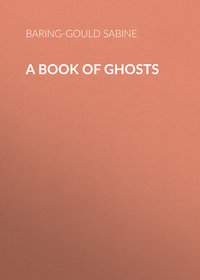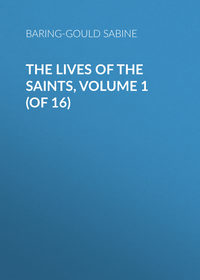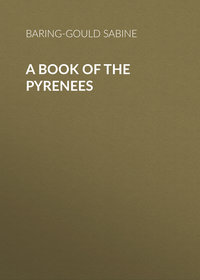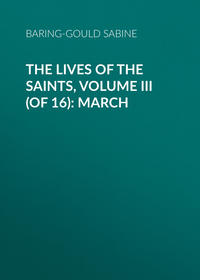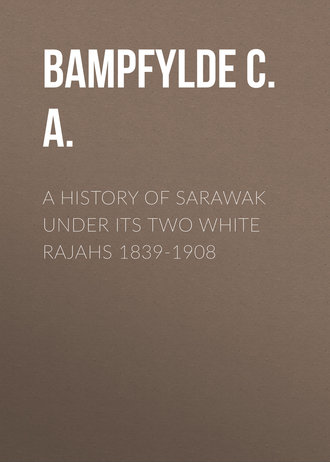 полная версия
полная версияA History of Sarawak under Its Two White Rajahs 1839-1908
In Kuching the work of the Mission lies chiefly amongst the Chinese. Kuap, which is within a day's journey of the capital, is a Land-Dayak village; the other Mission Stations are in districts populated by Sea-Dayaks, and the labours of the S.P.G. are chiefly confined to these people.
During the first six and a half years of Bishop Hose's episcopate, 1714 persons were baptized, and the number of native Christians had risen to 3480 in 1887.
For a full and interesting account of the work done by the Mission the reader is referred to Two Hundred Years of the S.P.G. (1701-1900).
That the Church in Borneo has done, and is still doing good, no one will dispute. It has not, however, extended its sphere of influence beyond its original limits, and within those limits, from Lundu to Kalaka, there is not only room, but the necessity for many more missionaries to labour than the Church is at present provided with. Missionary enterprise has not kept pace with the advance of civilisation. The large districts that since 1861 have reverted to the raj have been totally neglected by the S.P.G., and these districts, both in respect to area and population, constitute by far the greater part of Sarawak. But the Church in Sarawak is entirely dependent upon extraneous support, and when funds appear to be wanting, even to maintain the former efficient state of the Mission, and indications of retrogression are only too evident, there can be little hope for progression. A bishop cannot find missionaries, they must be sent to him, and he must be provided with the means to support them and their missions, and unless he is so far assisted he cannot be blamed for any shortcomings. To succeed, a mission, like other undertakings, must be based upon sound business principles. The isolated efforts of even the best men, men like Gomes,366 Chambers,367 Chalmers,368 and Perham,369 who have left their personal stamp upon the Mission, can be of little avail without continuity of effort and purpose, and to insure this a system is necessary, a system of trained missionaries, training others to take their places in due time, and for want of such a system the S.P.G. is now left with but two English missionaries in Sarawak.
To the deep regret of all in his diocese, failing health and advancing years necessitated the retirement of Bishop Hose at the end of 1907, after having spent the best years of his life in faithful service to the Church in the East. As far back as 1868 he was appointed Colonial Chaplain at Malacca. He was transferred to Singapore in 1872, and was appointed Archdeacon in 1874. For a little over twenty-six years he had been Bishop of a diocese of unwieldy size, over 120,000 square miles, containing a population of about two and a quarter millions, the supervision of which, with the two Archdeaconries separated by 450 miles of sea, necessarily entails a great deal of hard work and a considerable amount of travelling, and by reason of this it is proposed shortly to subdivide the diocese.370
The great Spanish Jesuit, one of the founders of the Jesuit Society, St. Francisco Xavier, the Apostle of India and the Far East, in 1542 laid the foundations of a missionary enterprise that scarcely has a parallel. Earnest and self-denying priests followed in his footsteps, and eventually some reached Borneo. Of the work of the earlier missionaries in Borneo we know hardly anything, but, as with Xavier at Malacca, they probably met with little success. They wandered away into the jungles, there to end their days amongst savage and barbarous people, at whose hands we know some met with martyrdom. They have left no traces and no records behind them, even their names are perhaps forgotten.
Fr. Antonio Vintimiglia, already mentioned in chapter ii. established a Roman Catholic Mission at Bruni, where he died in 1691; there may have been others there before him, but evidently he was the last Roman Catholic priest for many years in that part of Borneo with which this history deals.
In 1857, a Roman Catholic Mission was again established at Bruni, Labuan, and Gaya Bay, under a Spaniard named Cuateron, as Prefect Apostolic, who was assisted by two worthy Italian Priests. The romantic story of how Senor Cuateron became a priest, how he established the Mission, and how he obtained the means to do so, will be found in Sir Spenser St. John's Life in the Forests of the Far East. St. John tells us that the funds entrusted by Fr. Cuateron to the Papal Government as a permanent support for his Mission were diverted to other purposes, and the money he retained himself was dissipated in unsuccessful speculations. In 1861, nothing remained but closed churches and Fr. Cuateron. He remained for over fifteen years longer, and then he too disappeared.
In July, 1881, a Roman Catholic Mission to Borneo was founded in England, and attached to the foundation of this Mission there is also some romance, but of a different character to that which centred upon Fr. Cuateron. The Very Rev. Thomas Jackson, the first Vicar Apostolic, had so distinguished himself in the field in succouring the wounded during the last Afghan war as an acting Army chaplain, that he won a practical and well-deserved recognition from officers and men in the shape of a substantial testimonial, and this he devoted to the promotion of missionary work in Borneo. After travelling through North Borneo and Sarawak he selected Kuching as his headquarters. Supported by liberal aid from home, and well aided by zealous and self-devoted priests and sisters, before his retirement he had laid the foundations of a most flourishing mission. The Vicar Apostolic is now the Very Rev. E. Dunn, one of the first missionaries to join Mr. Jackson, and he, by his earnestness and kindliness, has won the respect of all. In Sarawak there are eleven European priests, two brothers, and eleven nuns and Sisters of Charity.
At Sibu, in the Rejang, there is an American Methodist Episcopal Mission under the charge of an American missionary. It was established in 1900, to look after the welfare of a number of Foo Chow Chinese agriculturists, who had been introduced from China and settled near Sibu, and who are all members of the American Methodist Church.
From every point of view, few countries offer such facilities and advantages for missionary work than are found in Sarawak. There is no spirit of antagonism to Christianity. Converts are exposed to no persecution, scorn, or even annoyance. By becoming Christians they do not lose caste, or the respect of their people. The lives and property of missionaries are absolutely safe wherever they may choose to settle, and, more, their coming will be welcomed. A man gifted with good sense and firmness, kindness of heart and courtesy, will soon make his influence felt, and gain, what is of paramount importance to the success of his undertaking, the respect of the people around him. Such a man will not fail to do a great deal of good, as such men have done before, but his labours will have been in vain unless there be another gifted with the same good qualities ready to take his place in due course.
1
Sultan is a title foreign to the Court language of Bruni. – Sir Hugh Low, G.C.M.G., Sarawak, 1848.
2
Rajah, correctly Raja. Plural is expressed by duplication.
3
In Bruni this title also is now debased by being granted to all natives, Chinese included.
4
St. John gives the di Gadong as Minister of Revenues, and the Pemancha as Minister for Home Affairs. —Forests of the Far East.
5
Pronounced by Malays Sherip, or Serip. Fem. Sheripa, Seripa. Sayid is another, though in the East less common title, assumed by descendants of the Prophet. Sir Richard Burton in his Pilgrimage says the former, men of the sword, the ruling and executive branch, are the descendants of El Husayn, the Prophet's grandson; and the latter, men of the pen, religion, and politics, are descended from the Prophet's eldest grandson, El Hasan. Siti is the female title.
6
A corruption of Tuan-ku (Tuan aku), my Lord, as it is often so pronounced.
7
The name Borneo is a corruption of Burni, itself a corruption of Beruni or Bruni, the capital of that ancient but now decayed Sultanate bearing the same name, and of which Sarawak, and a great part of British North Borneo, once formed parts. It was the first place in Borneo with which the Spanish and Portuguese had any dealings, and in their old chronicles it is referred to as Burni, and Borneo subsequently became the distinguishing name of the whole island to Europeans. The natives themselves have none, except perhaps the doubtful one of Pulau Ka-lamanta-an, the island of raw sago, so named in recent times by the merchants and traders of the Straits Settlements as being the island from which that commodity was brought, and in those settlements it has since become the native name for Borneo. But in Sarawak this name is known to the Malays alone, and in other parts of Borneo, perhaps only a few have heard of it. In fact, it is applicable to Sarawak only, for in former days sago was exported to the Straits solely from that country, and the trade was carried on by Sarawak Malays, first with Penang and subsequently with Singapore. An old English map of about 1700 gives to the town of Bruni, as well as to the whole island, the name of Borneo. Mercator (1595) also gives Borneo to both.
Bruni is variously spelt Brunai, Brunei, Bruné, Borneo, Borney, Bornei, Porne, and Burni by old writers; all corruptions of Bruni. The Sanskrit word Bhurni, meaning land or country, has been suggested as the origin of the name.
8
See page 34.
9
Everett (A. Hart). "Notes on the Distribution of the Useful Minerals in Sarawak," in the Journal of the Straits Branch of the Royal Asiatic Society, 1878. Mr. Everett was a distinguished naturalist. He served for eight years in the Sarawak service, and died in 1898.
10
Odoardo Beccari, Wanderings in the Great Forests of Borneo, 1904.
11
Probably the first European to discover these strange insects was the Italian Pigafetta, who in 1521 noticed them in the island of Palawan, to the north of Borneo, and thus quaintly describes them: "In this island are found certain trees, the leaves of which, when they fall off, are animated, and walk." He surmised they lived upon air. —Magellan, Hakluyt Society.
12
St. John mentions one that was killed at Brooketon 26 feet 2 inches in length. —Life in the Forests of the Far East, 1863.
13
With regard to the collection of orchids it has also been found necessary to do this. Collectors would ruthlessly destroy all orchids, especially the rarer kinds, which they could not carry away, in order to prevent others from collecting these.
14
In about 1825 a large bone was found in a cave at Bau which was pronounced to be that of an elephant. These animals are common in parts of N. Borneo, and Pigafetta found them at Bruni in 1521.
15
The Ptilocercus Lowii, only found in Borneo. It has been awarded a genus all to itself, and is one of the rarest of Bornean curiosities. – J. Hewitt, Sarawak Gazette, September 1, 1908.
16
"According to Mr. Boulanger, Borneo can boast of producing the longest legged frog and the longest legged toad in the world." —Idem.
17
"Mr. St. John (Forests of the Far East, p. 190) mentions stones or pebbles of a dark colour considered by the natives as sacred. Some such, found at Quop, were said to have been lost during the civil wars. They are possibly paleolithic implements." – Beccari, op. cit. p. 367.
18
The late Rajah wrote in 1838: "We know scarcely anything of these varieties of the human race beyond the bare fact of their existence." We have since learnt something of their languages and customs; of their origin nothing.
19
Mr. F. D. de Rozario. The Sarawak Gazette, September 2, 1901. Mr. de Rozario, the officer in charge of Kapit Fort, has been in the Government service for some fifty years, of which nearly all have been spent in the Upper Rejang, and his knowledge of the natives, their customs and languages, is unique.
20
See note 2, page 18.
21
The Indra Lila (brother of the Lila Pelawan, who was the present Rajah's Malay chief at Lingga over fifty years ago), was their chief. Trouble arose owing to Akam Nipa, the celebrated Kayan chief, who will be noticed hereafter, having fallen in love with a Malay girl of rank. His suit being rejected, he threatened to forcibly abduct the lady, a threat which he could have carried out with ease, so the Malays fled with her to Lingga. This occurred some eighty years ago.
22
One of Magellan's chroniclers records that in 1521 men were found in Gilo (Gilolo or Jilolo, to the east of, and near to the Celebes), "with ears so long and pendulous that they reached to their shoulders." —Magellan, Hakluyt Society. Marsden, History of Sumatra, says that the people of Neas island off the west coast of Sumatra elongate their ears in the same manner; so do the Sagais of Belungan. The sculptures above mentioned, and the fact that this curious custom still exists in southern India, point to it being one of Hindu origin.
23
Human sacrifices are still in vogue amongst the Kayans and Kenyahs in the Batang Kayan and Mahkam rivers.
24
The Kajamans, Sekapans, Sians, and Lanans are said to have been the first to cross over from the Bantang Kayan (Belungan) into the Balui (Rejang). They were probably then one tribe.
25
Muka is the Malay for face. The word has been carried into the English language as mug, contemptuously "an ugly mug," from the Sanskrit word muhka, the face.
26
Mr. E. A. W. Cox, formerly Resident of the Trusan, and latterly of the Bintulu, says the Kadayan tradition is that many generations back they were brought from Deli in Sumatra by a former Sultan of Bruni. They have always been the immediate followers of the sultans, forming their main bodyguard. They have no distinctive language of their own, and talk a low Bruni patois; their dress is peculiar; and their system of rice cultivation is far in advance of all other Borneans.
27
The Hindu sacred bull.
28
Writing of the Rafflesia, "those extraordinary parasitical plants, whose huge and startling conspicuous flowers spring from the ground like gigantic mushrooms," Beccari (op. cit. p. 102) says, "The Land-Dayaks called the variety he found at Poi (and which he named R. Tuan-Mudæ, in honour of the present Rajah) 'Bua pakma'; evidently a corruption of 'patma' or 'padma,' the sacred lotus (Nelumbian speciosum) of the Hindus, which is not a native of Borneo. This is, no doubt, one of the many traces of the ancient faith once professed by the Dayaks, who have preserved the memory of the emblematical flower, transferring its name to that of another plant conspicuous for its size and singular appearance. In Java, as well as in Sumatra, the Rafflesia is known as 'Patma'; but there the fact is not surprising, for the prevalence of Hinduism in those islands is a matter of not very remote history." Pakma or patma is the Malay name for the lotus.
The late Sir Hugh Low notes that the Land-Dayaks, who (in common with most of the inland tribes) regulate their farming seasons by the motions of the Pleiades, call that constellation Sakara, probably from the Batara Sakra of the Hindu-Javan mythology, to whose particular care the earth was confided. —Sarawak.
Hindu gold ornaments and a Persian coin, bearing a date corresponding with the year 960 A.D., have been discovered up the Sarawak river, and some in the centre of the Land-Dayak country, which shows that the people of the ancient Hindu-Javan settlement at Santubong must have spread into the interior, and have mixed with the natives.
29
Afterwards Admiral of the Fleet.
30
Disappointment in marriage and unkindness or harshness on the part of relatives are common causes of suicide by man or woman, but the most common motive is shame, particularly in cases of an unmarried woman, when enceinte, being unable to prove to the tribe who the father of her child is. A whole family has been known to poison themselves to escape the consequences and disgrace which would have befallen them owing to one of them having been the accidental cause of a long communal house being destroyed by fire. Suicide is invariably committed by eating the poisonous root of the tuba plant, derris elliptica.
31
The worst on record in Sarawak was committed in 1894 by a half-bred Chinaman (his mother was a Segalang, and he was brought up as one) at Seduan village, three miles from Sibu, in the Rejang. This man, who had just been discharged from jail, arose in the middle of the night, and speared or cut down all the inmates of the house – thirteen women and children, of whom only two or three survived. He was shot by Mr. Q. A. Buck, then the Resident at Sibu (joined 1874, retired 1899), who was quickly on the spot, and was the means of preventing a further loss of life.
32
The Sea-Dayaks say that they were constructed by the gods when they made the sky, out of a small surplus of the blue.
33
St. John, op. cit., mentions that the late Sultan Mumin of Bruni had an ancient jar which was reputed to be able to speak, and that it moaned sorrowfully the night before his first wife died. He refused £2000 for it.
34
Naga, a dragon; benaga, having a dragon.
35
Meaning a deer in Malay and Sea-Dayak.
36
A misprint for "Tunggang."
37
Late Resident-General of the Federated Malay States.
38
This was written in 1866.
39
Amongst Eastern people any attempt to make a systematic census is liable to be misapprehended, and to give rise to a bad feeling, and even to dangerous scares, and for that reason no census has been made by the Government. This census was an approximation based upon the amount paid in direct taxation, such as head and door taxes, allowing an average of so many people to a family.
40
And so Orang-Murut means a hill-man, murut, or more correctly murud, meaning a hill —bulud in Sulu.
41
Mr. J. Hewitt, B.A., Curator of the Sarawak Museum in the Sarawak Gazette, February 2, 1906.
42
Kuching Observatory.
43
The Sarawak Gazette.
44
Named by the Spaniards Mount St. Paul according to Pigafetta. J. Hunt gives St. Peter's Mount in his Sketch of Borneo, 1812, and a map by Mercator published in about 1595 gives St. Pedro, and old maps of subsequent dates also give the latter name.
45
But Mr. C. Vernon-Collins, of the Sarawak Civil Service, recently found a bead which has been pronounced at the British Museum to have been made in Venice prior to A.D. 1100. A similar one of the same date was presented by H.H. the Ranee to the British Museum some years ago. It is a bead highly esteemed by the Kayans.
46
"Book of the Descent," Sir Hugh Low. —Journal of the Straits Branch of the R.A.S., No. 5.
47
Jewata is the Land-Dayak name of a god from the Sanskrit word dewata, divinity, deity, gods. The Sea-Dyaks also have Jewata in their mythology, likewise Batara, from the Sanskrit bhatar, holy; neither means God, as some writers appear to think. The Dayaks have no idea of theism.
48
The late Rajah has recorded a tradition of several of the Land-Dayak tribes that in the old times they were under the government of Java, and their tribute was regularly sent there.
49
The title assumed by the rulers of Majapahit, from "Bhatara," noted above.
50
According to Crawfurd. Sir Stamford Raffles gives 1475.
51
Formerly a monarchy whose jurisdiction comprehended all Sumatra, and whose sovereign was talked of with respect in the farthest parts of the East. – Marsden's History of Sumatra.
52
Lima is a small town on the north coast of Portugal.
53
Sir Hugh Low, Book of the Descent, op. cit.
54
See note 2, p. 45.
55
A Collection of Voyages, 1729, Dampier.
56
Idem.
57
Forrest's Voyage to New Guinea, 1779.
58
Sarawak, Hugh Low, 1848.
59
Hunt, op. cit.
60
Dias, in 1487.
61
"Antiquity of Chinese Trade," J. R. Logan in the Journal of the Indian Archipelago, 1848.
62
Forrest, op. cit.
63
Logan, op. cit.
64
Mercator's map gives Melano, which confirms this supposition. Other places on the Sarawak coast mentioned in this map are Tamaio-baio, Barulo (Bintulu), Puchavarao (Muka), Tamenacrim, and Tamaratos. The first and two last cannot be identified. Tama is of course for tanah, land, and the last name simply means in Malay, the land of hundreds – of many people, which the first name may also imply. Varao being man in Spanish and Portuguese, Puchavarao means the place of the Pucha (Muka) people – Pucha also being a transcriber's error for Puka. It was near this place that the Portuguese captain, who afterwards became a Bruni pangiran (p. 42) was wrecked, and also near this place on Cape Sirik, a point which is continually advancing seaward, that some forty to fifty years ago the remains of a wreck were discovered a considerable distance from the sea, and so must have belonged to a ship wrecked many years before. When Rentap's stronghold in the Saribas was captured by the present Rajah in 1861, an old iron cannon dated 1515 was found there. Traditions exist pointing to wrecks and to the existence of hidden treasure at two or three places along the coast.
65
Meaning queen-consort.
66
Probably the Kalaka; the Malays in the Rejang came from that river.
67
A Voyage to and from the Island of Borneo, 1718.
68
The Dutch confiscated all foreign ships they could seize found trading in the Archipelago without permission from them to do so.
69
Borneo and Sumatra were then the great pepper producing countries.
70
Forrest, op. cit., confirms this, and adds "the Dutch forbid the natives to manufacture cloth."
71
Sir Hugh Low, op. cit.






